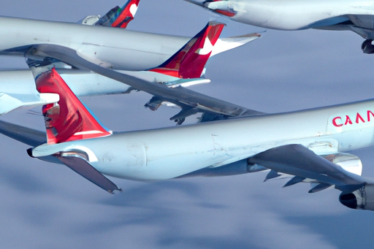Impact of COVID-19 on Global Air Traffic
Global Air Traffic Reaches 95.7% of Pre-COVID Levels in August; APAC Leading Regions
The COVID-19 pandemic has had a profound impact on various sectors of the global economy, and the aviation industry is no exception. With travel restrictions, lockdowns, and fear of the virus, air traffic plummeted to unprecedented lows. However, there is a glimmer of hope on the horizon as global air traffic has started to recover, reaching 95.7% of pre-COVID levels in August.
The Asia-Pacific (APAC) region has emerged as a leader in this recovery, with several countries successfully containing the virus and gradually reopening their borders. This has led to a significant increase in domestic and international air travel within the region. APAC’s success can be attributed to its swift response to the pandemic, effective contact tracing, and strict quarantine measures.
China, the world’s second-largest aviation market, has played a crucial role in driving the recovery in the APAC region. The country has managed to control the spread of the virus and has seen a surge in domestic air travel. Chinese airlines have been quick to adapt to the new normal, implementing stringent health and safety measures to ensure passenger confidence. As a result, China’s domestic air traffic has almost fully recovered to pre-pandemic levels.
Other countries in the APAC region, such as South Korea, Japan, and Australia, have also seen a steady increase in air traffic. These countries have successfully contained the virus through rigorous testing, contact tracing, and strict quarantine measures. As a result, domestic air travel has rebounded, and international flights have gradually resumed, albeit with certain restrictions.
In contrast, the recovery in other regions has been slower. Europe, once a bustling hub for international travel, has been hit hard by the pandemic. Travel restrictions and quarantine measures have severely impacted the aviation industry, leading to a sluggish recovery. However, some European countries, such as Germany and France, have seen a gradual increase in air traffic as they ease restrictions and implement safety protocols.
North America, another major aviation market, has also been grappling with the effects of the pandemic. The United States, in particular, has seen a significant decline in air travel due to the high number of COVID-19 cases. However, as the situation improves and travel restrictions are lifted, air traffic is slowly picking up.
The recovery of global air traffic is not without its challenges. The threat of new variants and the possibility of future waves of the virus continue to loom over the industry. Governments and airlines must remain vigilant and adapt quickly to changing circumstances to ensure the safety of passengers and crew.
Despite these challenges, the gradual recovery of air traffic is a positive sign for the aviation industry and the global economy as a whole. It signifies a return to normalcy and a revival of international trade and tourism. As more countries successfully control the spread of the virus and reopen their borders, we can expect air traffic to continue its upward trajectory.
In conclusion, global air traffic has made significant strides in recovering from the impact of the COVID-19 pandemic. The APAC region, led by China, has been at the forefront of this recovery, with domestic and international air travel reaching almost pre-pandemic levels. Other regions, such as Europe and North America, are also seeing a gradual increase in air traffic as restrictions are eased. While challenges remain, the recovery of air traffic is a promising sign for the aviation industry and the global economy.
Recovery of Air Travel in the Asia-Pacific Region
Global Air Traffic Reaches 95.7% of Pre-COVID Levels in August; APAC Leading Regions
The recovery of air travel in the Asia-Pacific region has been nothing short of remarkable. As the world continues to grapple with the effects of the COVID-19 pandemic, the Asia-Pacific region has emerged as a leader in the recovery of air traffic. In August, global air traffic reached an impressive 95.7% of pre-COVID levels, with the Asia-Pacific region leading the way.
One of the key factors contributing to the recovery of air travel in the Asia-Pacific region is the successful containment of the virus in many countries. Governments in the region have implemented strict measures to control the spread of COVID-19, including widespread testing, contact tracing, and quarantine protocols. These efforts have helped to instill confidence in travelers and have paved the way for the resumption of air travel.
Another factor driving the recovery of air travel in the Asia-Pacific region is the strong domestic market. With international travel restrictions still in place in many countries, domestic travel has become the lifeline for airlines. Countries like China, Japan, and Australia have seen a surge in domestic travel as people seek to explore their own backyard. This has provided a much-needed boost to airlines and has helped to offset the decline in international travel.
In addition to the strong domestic market, the Asia-Pacific region has also benefited from the gradual reopening of international borders. As countries in the region have successfully controlled the spread of the virus, they have started to ease travel restrictions and allow for the resumption of international flights. This has allowed airlines to gradually rebuild their international networks and has provided travelers with more options for their journeys.
Furthermore, the Asia-Pacific region has seen a rise in travel bubbles and green lane arrangements. These agreements between countries allow for the resumption of travel with minimal restrictions for travelers who meet certain criteria, such as having a negative COVID-19 test result. Travel bubbles and green lanes have been particularly successful in the region, with countries like Singapore, Australia, and New Zealand establishing such arrangements. These initiatives have not only facilitated the recovery of air travel but have also helped to boost tourism and revive economies.
The recovery of air travel in the Asia-Pacific region has not been without its challenges, however. The ongoing threat of new variants of the virus and sporadic outbreaks have led to occasional disruptions in air travel. Airlines and governments have had to remain vigilant and adapt quickly to changing circumstances to ensure the safety of travelers and the continuity of air services.
Looking ahead, the recovery of air travel in the Asia-Pacific region is expected to continue, albeit at a gradual pace. As vaccination rates increase and the global situation improves, more countries are likely to ease travel restrictions and open their borders. This will further stimulate demand for air travel and support the recovery of the aviation industry.
In conclusion, the recovery of air travel in the Asia-Pacific region has been impressive, with global air traffic reaching 95.7% of pre-COVID levels in August. The successful containment of the virus, strong domestic market, gradual reopening of international borders, and the establishment of travel bubbles and green lanes have all contributed to this recovery. While challenges remain, the future looks promising for the aviation industry in the Asia-Pacific region.
Factors Contributing to the Increase in Global Air Traffic
Global Air Traffic Reaches 95.7% of Pre-COVID Levels in August; APAC Leading Regions
The aviation industry has been severely impacted by the COVID-19 pandemic, with travel restrictions and lockdowns leading to a significant decrease in air traffic. However, there is some good news on the horizon as global air traffic has started to recover, reaching 95.7% of pre-COVID levels in August. This is a positive sign for the industry and a step towards returning to normalcy.
Several factors have contributed to this increase in global air traffic. One of the key factors is the easing of travel restrictions in many countries. As vaccination rates increase and the number of COVID-19 cases decline, governments are gradually lifting travel bans and quarantine requirements. This has encouraged people to start traveling again, leading to a surge in air traffic.
Another factor that has contributed to the increase in air traffic is the growing confidence among travelers. With the availability of vaccines and improved safety measures at airports and on airplanes, people are feeling more comfortable about flying. They are reassured by the stringent health and safety protocols implemented by airlines and airports to minimize the risk of COVID-19 transmission. This increased confidence has resulted in a higher demand for air travel, further boosting global air traffic.
The Asia-Pacific (APAC) region has emerged as a leader in the recovery of air traffic. Countries like China, Japan, and South Korea have successfully contained the spread of the virus and have been able to reopen their economies. As a result, domestic air travel in these countries has rebounded strongly. Additionally, the APAC region has also seen an increase in international travel, with countries like Singapore and Thailand reopening their borders to vaccinated travelers. The strong recovery in the APAC region has played a significant role in driving the overall increase in global air traffic.
Furthermore, the availability of affordable airfares has also contributed to the rise in air traffic. Airlines have been offering discounted fares and attractive travel packages to entice passengers. This has made air travel more accessible and affordable for many people, leading to an increase in demand. The combination of affordable fares and pent-up travel demand has resulted in a surge in bookings, further boosting global air traffic.
The recovery of air cargo has also played a role in the increase in global air traffic. With the disruption of global supply chains during the pandemic, there has been a significant increase in demand for air cargo services. As a result, airlines have been operating more cargo flights to meet this demand. The increase in air cargo traffic has contributed to the overall increase in global air traffic, as airlines utilize their passenger aircraft for cargo operations.
In conclusion, the increase in global air traffic is a positive sign for the aviation industry. The easing of travel restrictions, growing confidence among travelers, strong recovery in the APAC region, availability of affordable airfares, and the rise in air cargo traffic have all contributed to this increase. While the industry still has a long way to go before it fully recovers, these factors provide hope for a brighter future for air travel. As more people get vaccinated and travel restrictions continue to ease, we can expect to see further growth in global air traffic in the coming months.


